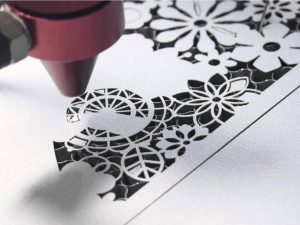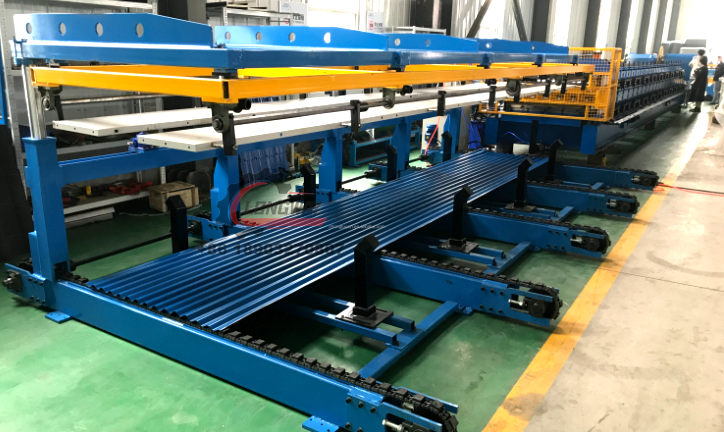A History of Laser Cutting-standing seam metal roof machine
When you hear the word “laser,” what do you think of? For many people, lasers bring to mind images of Star Wars lightsabers and sci-fi movies. While lasers often feature in popular culture, many industries use laser technology as part of their manufacturing processes to cut and engrave materials. In fact, you’ve almost certainly encountered a product made using laser cutters.
Although laser cutting seems like modern technology, the history of laser cutting may surprise you. The first lasers had their roots in Einstein’s theoretical work and followed a fascinating path before becoming the higher power lasers used in many industries today. Let’s trace the history of laser cutting from Einstein through to the first working laser and beyond to the modern day.
Auto Stacker ,Roof sheet stacker
What Is Laser Cutting?
Laser cutting is a technique used to cut or engrave hard materials by burning, melting or vaporizing. The process has multiple industrial applications across various industries and can be used to drill holes or cut shapes in metal and other materials on a production line. Laser cutting is also used as an artistic technique to engrave decorative designs on surfaces.The primary advantage of laser cutting technology is its accuracy, and the high power beam is concentrated through a laser cutting nozzle for pinpoint accuracy. Modern laser cutting generally uses CAD technology, allowing artists and engineers to create intricate designs with an industrial laser.
How Does Laser Cutting Work?
 A laser works by energizing the atoms in a solid, liquid or gas medium. This requires an energy pump, which could be an electrical current or even a second laser. As the atoms in the medium absorb energy, they start emitting light. This light is concentrated by placing a mirror at each end of the medium, creating an optical cavity.Laser cutting works by focusing a laser beam onto sheet metal or another hard material. Mirrors, lenses and compressed gases such as carbon dioxide allow technicians to adjust the laser beam focus through a laser cutting nozzle.The narrow beam then melts or burns away the material, and the technician can then move to the next area by moving the cutting materials or laser head. CAD technology allows the laser head to move across the cutting sheet metal or other material automatically.
A laser works by energizing the atoms in a solid, liquid or gas medium. This requires an energy pump, which could be an electrical current or even a second laser. As the atoms in the medium absorb energy, they start emitting light. This light is concentrated by placing a mirror at each end of the medium, creating an optical cavity.Laser cutting works by focusing a laser beam onto sheet metal or another hard material. Mirrors, lenses and compressed gases such as carbon dioxide allow technicians to adjust the laser beam focus through a laser cutting nozzle.The narrow beam then melts or burns away the material, and the technician can then move to the next area by moving the cutting materials or laser head. CAD technology allows the laser head to move across the cutting sheet metal or other material automatically.
What Are the Types of Laser Cutters?
Laser cutters are defined by their laser medium. A solid state laser uses a material such as ruby or glass to create a focused laser beam. Gas laser cutting uses a gas (usually CO2), and a liquid laser requires a liquid medium. The most common types of laser cutting are:
- Gas laser cutting: The gas laser cutting process is often known as CO2 laser cutting. A CO2 laser cutter fires a laser beam through a CO2 mixture. This technique is generally used for cutting nonmetal materials like wood.
- Crystal laser cutting: Crystal laser cutters can cut and engrave various materials, including metal and nonmetal surfaces. However, they aren’t especially durable and are expensive to build and run.
- Fiber laser cutting: A fiber laser cutter is the most recently invented laser machine. Such a machine uses a medium made of optical fibers and is less expensive to make than gas or crystal laser cutters. Another advantage of fiber lasers is their higher power output. This economical cutting tool is suitable for various metal and nonmetal materials.
Who Invented Laser Cutting?
The history of laser cutting began back in 1917 when Albert Einstein came up with the theory of “stimulated emission of radiation,” the principle behind the modern laser. He theorized that electrons could emit photons when they absorbed enough energy to move up an energy level within an atom.In 1959, a scientist called Gordon Gould expanded on Einstein’s theory. He suggested that the stimulated emission of radiation could be used to amplify light. His theory was dubbed Light Amplification by Stimulated Emission of Radiation — or LASER for short.Jump forward a year to 1960, when Theodore Maiman created the first-ever working laser in a California laboratory. He used synthetic ruby to generate a deep red beam, although many of his contemporaries couldn’t see a use for his ruby laser. In fact, the technology was described as “a solution looking for a problem” and was met with skepticism and even suspicion by the public. However, many members of the scientific community saw the potential in Maiman’s invention, including scientists at Bell Labs in New Jersey.It wasn’t until 1964 that a scientist at Bell Labs finally developed thermal cutting techniques using lasers. Kumar Patel invented a gas laser cutting process using a carbon dioxide mixture and found it to be a quicker and more cost-effective improvement on ruby laser cutting. His colleague at Bell Labs, J.E. Geusic, invented the crystal laser process later that year. The invention captured the popular imagination, and it was featured in a famous scene in the 1964 film Goldfinger, during which the titular villain attempted to cut James Bond in two with a laser beam.
Which Was the First Group to Use a Laser Cutter?
The first group to use laser cutting was the Western Engineering Research Center in Buffalo, New York, in 1965. The group wanted to find a more efficient way to manufacture electrical wires. At the time, manufacturers used diamond dies to extrude metal wire, and the die holes were expensive, difficult and time-consuming to drill.The Western Engineering Research Center pioneered the use of focused laser beam cutting to drill the holes more quickly. This was a crucial moment in the history of laser cutting and paved the way for other companies to explore potential uses for laser technology. Much of the group’s work concentrated on finding out more about the safety of laser beams and their potential effects on human health.
A History of Laser Cutting Uses
Shortly after the Western Engineering Research Center started using laser cutting technology as a drilling technique, scientists developed the gas laser cutting method using carbon dioxide. This development made laser cutting technology more versatile. The development of lasers capable of cutting through metals such as mild steel was particularly crucial to the technology’s widespread adoption.In 1969, the Boeing company became the first company to use gas laser cutting commercially. Three of its employees co-wrote a paper exploring the concept of using a carbon dioxide laser to cut titanium, Hastelloy and ceramic. This paper led to the development of multi-beam laser cutting, and Boeing started using laser beams as an efficient cutting process on its production lines. Western Electric started mass-producing cutting machines that were widely used in the aerospace industry during the 1970s.The use of gas laser cutting became widespread during the 1980s. It’s thought that roughly 20,000 industrial laser cutters were in use during this period, with a collective value of about $7.5 billion. In fact, laser cutting techniques revolutionized production industries to such an extent that Professor Bill Steen said their invention hailed the beginning of a new industrial revolution.In 1979, we reached another pivotal moment in the history of laser cutting. Until this point, laser cutting was two-dimensional. Prima Industrie of Collegno, Italy, invented a 3D laser cutting technique that significantly expanded the potential applications of laser cutting technology.
Laser Technology Today
Laser cutting has come a long way since the Boeing company produced laser-drilled dies in the late 60s. Nowadays, laser power is widely used in various industries, particularly in car manufacture. Advances in laser cutting technology mean that the technique can be used on thicker and more varied materials, from metal to ceramic and even paper. Fiber and CO2 laser cutting methods allow manufacturers to cut materials significantly faster than previous techniques, enabling them to scale up production while cutting down on labor hours.Simply look around your home and you’ll almost certainly find a product cut or engraved using lasers. Many industries use lasers to engrave logos or text onto products, such as the letters on your computer’s keyboard.
What’s Next?
 It’s not the end of the road for technological developments in laser cutting. Engineers and scientists continue to innovate, and this is likely to lead to the development of even more powerful laser cutting machines to increase thickness capacity, cutting speeds and precision. Advances in automation will allow production lines to operate unmanned 24 hours a day and enable safer working environments for technicians working with laser cutting machines.
It’s not the end of the road for technological developments in laser cutting. Engineers and scientists continue to innovate, and this is likely to lead to the development of even more powerful laser cutting machines to increase thickness capacity, cutting speeds and precision. Advances in automation will allow production lines to operate unmanned 24 hours a day and enable safer working environments for technicians working with laser cutting machines.
Talk to the Laser Cutting Machine Experts
Laser cutting is a fascinating technology with an interesting and often surprising history. To get the most out of this precise and efficient technology, you need the correct equipment.Thunder Laser USA is one of America’s premier manufacturers of powerful and high-quality CO2 laser cutting machines. Whether you need a machine for etching, engraving or cutting, Thunder Laser USA can help you find the right product for your unique requirements. Get in touch with the expert customer service team to discuss your needs and explore how the right laser cutting machines could benefit your business.
-
Roof Panel Machines: Buying Guide, Types, and PricingNewsJul.04, 2025
-
Purlin Machines: Types, Features, and Pricing GuideNewsJul.04, 2025
-
Metal Embossing Machines: Types, Applications, and Buying GuideNewsJul.04, 2025
-
Gutter Machines: Features, Types, and Cost BreakdownNewsJul.04, 2025
-
Cut to Length Line: Overview, Equipment, and Buying GuideNewsJul.04, 2025
-
Auto Stacker: Features, Applications, and Cost BreakdownNewsJul.04, 2025
-
Top Drywall Profile Machine Models for SaleNewsJun.05, 2025









